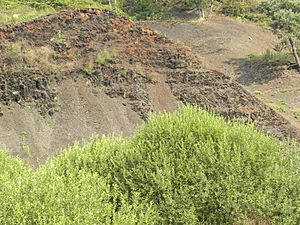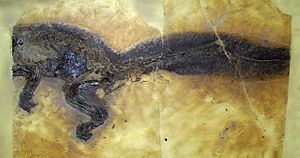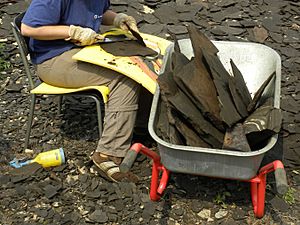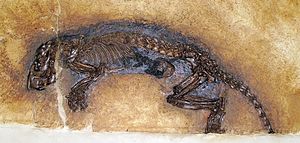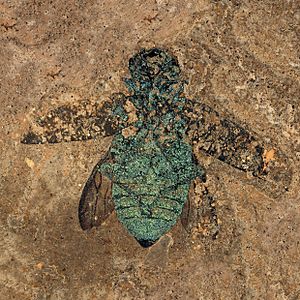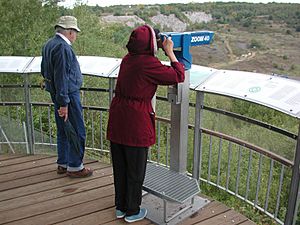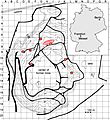Messel Pit facts for kids
Quick facts for kids Messel Pit Fossil Site * |
|
|---|---|
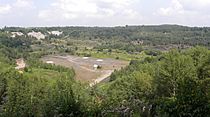 |
|
| Country | |
| Type | Natural |
| Criteria | viii |
| Reference | 720 |
| Region ** | Europe |
| Inscription history | |
| Inscription | 1995 (19th Session) |
|
|
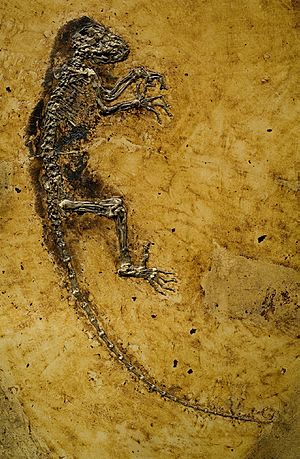
The Messel Pit (called Grube Messel in German) is an old quarry near the village of Messel in Hesse, Germany. It is about 35 kilometers (22 miles) southeast of Frankfurt. This site is very special because it has incredibly well-preserved fossils. Places like this, known for their amazing fossils, are called lagerstättes.
People used to mine a type of rock called bituminous shale here. This rock is important because it holds many fossils. The Messel Pit has great geological and scientific value. For a while, there were plans to turn it into a landfill. But local people fought hard against this idea. Because of their efforts, the Messel Pit became a UNESCO World Heritage Site in 1995. It earned this title only because of its unique fossils.
Amateur fossil collectors helped create a special "transfer technique." This method lets them keep the tiny details of small fossils safe. This same technique is still used today to preserve the fossils found at Messel. Many fossils from the site were first found by these amateur collectors. In 1996, a special rule was made. It allowed people to return privately owned fossils without trouble. This helped bring many important fossils back to public collections for science.
Contents
Ancient Environment: The Messel Pit's Past
Today, the Messel Pit is about 60 meters (200 feet) lower than the land around it. It covers an area of about 0.7 square kilometers (0.27 square miles). The oil-shale rock originally went down 190 meters (620 feet) deep.
About 47 million years ago, during a time called the Eocene epoch, the Messel area was different. It was about 10 degrees further south than it is now. The climate was much warmer, and the area was covered by thick, sub-tropical forests. A large series of lakes filled the pit, surrounded by these lush forests. This environment supported many different kinds of life. The Messel lake bed likely collected water from nearby rivers and streams.
The rocks and fossils in the pit formed during the Eocene epoch. This was about 47 million years ago. Scientists know this age by dating tiny pieces of basalt rock found under the fossil layers.
How Fossils Were Preserved
The main rock at the site is oil shale. This rock formed slowly from mud and dead plants that settled at the bottom of the lake. The lake bottom had very little oxygen, a condition called anoxic.
The sediments, or layers of mud, go down 130 meters (426 feet). They sit on top of older sandstone. The fossils in the shale are incredibly clear and well-preserved. This is because of the special way the lake layers formed.
The top layers of the lake had lots of life. But the bottom was anoxic, meaning it had almost no oxygen. The water at the bottom did not mix much, so very little oxygen reached the deeper parts. This stopped many creatures from living on or in the lakebed. Because of this, dead animals and plants were not eaten or broken down. This helped them turn into fossils.
Sometimes, the lake layers would mix, like during seasonal changes. This would bring water with low oxygen to the surface. This caused many water animals to die suddenly. This, along with the slow rate of new mud settling (about 0.1 millimeters per year), created a perfect place for fauna (animals) and flora (plants) to become fossils.
Volcanic Gas and Ancient Life
The area around the Messel Pit was very active with volcanoes and earthquakes during the Eocene. Scientists think that gases released from these volcanoes helped preserve many land animals.
Deep underground shifts could release large amounts of gases like carbon dioxide and hydrogen sulfide. These gases would rise into the lake and the areas around it. They would kill animals that were sensitive to them. For example, birds and bats flying near the lake might have fallen in. Land animals near the shore could have been overcome by the gases.
Amazing Fossils from Messel Pit
The Messel Pit has the best-preserved evidence of early Eocene plants and animals found anywhere. In most other places, you might only find parts of skeletons. But at Messel, fossils are often complete. You can even see the fur, feathers, and outlines of skin on some animals. This amazing preservation has led to some interesting discoveries.
For example, scientists found a fossilized leaf with "dumb-bell"-shaped bite marks. These marks were on either side of the leaf's main vein. They were made by a carpenter ant that was infected by a fungus. This fungus, just like some today, took over the ant's behavior. It made the ant bite the leaf in a specific way to release the fungus's spores. This is the earliest clear example of a fungus controlling an animal's behavior.
The variety of species found here is incredible. Here are some of the fossils discovered at the site:
- An early primate fossil, Darwinius masillae, was found. It has features similar to anthropoids (like monkeys and apes), not lemurs. This discovery was announced in May 2009.
- Nine pairs of turtles were found fossilized while mating. They must have died very quickly. Scientists believe the turtles started mating in the oxygen-rich surface waters of the ancient lake. As they sank into deeper water, they were killed by toxic volcanic gas. Then, they were buried in the lakebed mud. Turtles like these still live today. They have lost their scales and can absorb oxygen through their skin. This helps them stay underwater for a long time. But in water with no oxygen and dissolved poisons, this ability becomes dangerous.
- Over 10,000 fossilized fish from many different species.
- Thousands of insects, both water and land dwellers. Some still show their original colors.
- Many small mammals, including tiny horses, large mice, primates, and ground animals like hedgehogs, marsupials, pangolins, and aardvark relatives. Many bats have also been found.
- Many birds, especially those that hunted other animals.
- Crocodiles, frogs, turtles, salamanders, and other reptiles or amphibians.
- Remains of over 30 plant species. These include palm leaves, fruits, pollen, wood, walnuts, and grapevines.
See also
Lagerstätte  In Spanish: Sitio fosilífero de Messel para niños
In Spanish: Sitio fosilífero de Messel para niños
Images for kids


